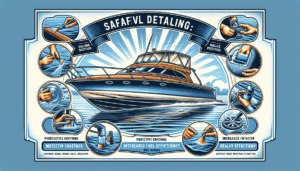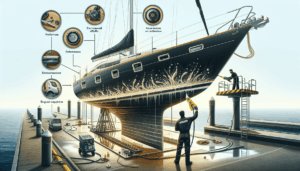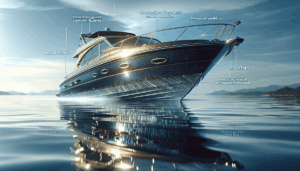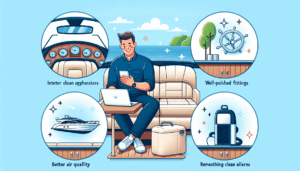Are you a boat owner who wants to keep your vessel looking pristine and protected from rust and corrosion? Look no further! In this article, we’ll be discussing the top 5 benefits of boat detailing in preventing rust and corrosion. As experts in the field of vehicle and boat detailing, Ace Mobile Detailing understands the importance of maintaining the appearance and longevity of your boat. From protecting the exterior from saltwater damage to preserving the interior surfaces, boat detailing offers a range of benefits that will leave you feeling amazing every time you set sail. So, let’s dive into the world of boat detailing and discover how it can safeguard your prized possession!

Protection against moisture
Moisture is a common enemy of boats, as it can lead to rust formation and damage to various components. To protect your boat from moisture-related issues, there are several important steps you can take.
Removal of water deposits
Water deposits can accumulate on the surface of your boat, especially after a day out on the water. These deposits can leave behind unsightly marks and can also contribute to the formation of rust. To remove water deposits effectively, you can use a boat-specific cleaner and a soft cloth or sponge. It is important to thoroughly dry the surface afterwards to prevent any moisture from remaining.
Application of sealant
To provide an extra layer of protection against moisture, it is recommended to apply a high-quality sealant to your boat. Sealants are designed to create a barrier that prevents water from penetrating the surface of your boat. By sealing the boat, you can significantly reduce the chances of moisture-related damage and increase its longevity.
Prevention of rust formation
Rust is a common issue in boats due to the constant exposure to water. To prevent rust formation, it is crucial to regularly inspect and maintain metal surfaces. This includes checking for any signs of rust and treating it promptly. Additionally, applying a rust inhibitor can help to protect metal surfaces from future corrosion.
Preservation of paintwork
The paintwork of your boat not only contributes to its aesthetic appeal but also serves as a protective layer. To ensure that your boat’s paintwork remains in top condition and effectively protects the underlying structure, regular maintenance is essential.
Cleaning and polishing
Regular cleaning and polishing of your boat’s paintwork can help to remove dirt, debris, and oxidation. This not only keeps your boat looking its best but also helps to prolong the life of the paint. When cleaning and polishing, it is important to use products specifically designed for the marine environment to avoid damaging the paint.
Removal of oxidation
Over time, oxidation can occur on the surface of your boat’s paint, leading to a dull and faded appearance. If left untreated, oxidation can cause the paint to deteriorate further and leave it vulnerable to damage. By using an oxidation remover and following up with polishing and waxing, you can restore the shine and protect the paintwork.
Application of wax or protective coating
To provide added protection to your boat’s paintwork, it is recommended to apply a wax or protective coating. These products create a barrier against UV rays, saltwater, and other environmental factors that can damage the paint. Regular application of wax or protective coating helps to maintain the integrity of the paint and keep it looking new.
Prevention of saltwater damage
Saltwater can be particularly damaging to boats due to its corrosive nature. To prevent saltwater damage and ensure the longevity of your boat, it is important to take appropriate measures.
Thorough cleaning of salt residue
After each trip on saltwater, it is crucial to thoroughly clean your boat to remove any salt residue. Salt can quickly corrode metal surfaces and cause damage if not properly taken care of. Using a mild detergent and freshwater, wash down the entire boat, paying special attention to areas prone to salt buildup, such as the hull and metal fittings.
Application of corrosion inhibitors
To provide an extra layer of protection against saltwater damage, you can apply corrosion inhibitors to vulnerable metal surfaces. These inhibitors work by forming a protective barrier that prevents saltwater from coming into direct contact with the metal. Regular application of corrosion inhibitors can significantly reduce the risk of corrosion and prolong the life of your boat.
Protection of metal surfaces
Metal surfaces, such as propellers, hardware, and fittings, are particularly susceptible to saltwater damage. To protect these surfaces, it is recommended to use appropriate coatings, such as zinc or aluminum anodes. These sacrificial coatings help redirect the corrosive action away from the metal, preventing rapid deterioration.
Maintenance of electrical components
Electrical components are essential for the proper functioning of a boat, and their maintenance is crucial to prevent malfunctions and potential hazards.
Inspection and cleaning of connections
Regularly inspecting and cleaning the electrical connections on your boat can help prevent issues caused by corrosion, dirt, or loose connections. It is important to ensure that all connections are clean, tight, and free from any signs of damage. A mild electrical contact cleaner can be used to remove any dirt or corrosion present.
Protection against water ingress
Water ingress can be detrimental to electrical components and lead to malfunctions or short circuits. To protect against water ingress, make sure that all electrical connections, wiring, and components are properly sealed and insulated. Waterproof connectors and heat shrink tubing can be used to provide additional protection.
Preservation of wiring integrity
The integrity of the boat’s wiring is crucial for proper electrical functioning. Regularly inspecting the wiring for any signs of wear, damage, or fraying can help identify potential issues before they escalate. Any damaged or deteriorated wiring should be promptly replaced to prevent further damage and ensure the safety of your boat.

Enhancement of fuel efficiency
Improving fuel efficiency in your boat not only saves you money but also reduces your environmental impact. Regular maintenance and the following steps can help optimize your boat’s fuel efficiency.
Removal of marine growth
Marine growth, such as barnacles and algae, can significantly increase drag and reduce fuel efficiency. Regularly inspecting and cleaning the hull and other underwater surfaces can help prevent the accumulation of marine growth. Antifouling paints or coatings can also be applied to inhibit the growth of marine organisms.
Optimization of hull smoothness
A smooth hull reduces drag and improves fuel efficiency. Ensuring that your boat’s hull is properly cleaned, polished, and free from any imperfections can help optimize its smoothness. Regularly inspecting the hull for any signs of damage, such as scratches or blisters, and addressing them promptly can also contribute to improved fuel efficiency.
Reduction of drag
Reducing unnecessary drag can have a significant impact on fuel efficiency. This can be achieved by ensuring that all non-essential equipment, such as fishing gear or water toys, are properly stowed away when not in use. Keeping the boat’s bottom clean and smooth, as well as minimizing wind resistance by trimming sails or adjusting the boat’s position, can further reduce drag and enhance fuel efficiency.
Overall, regular boat detailing and maintenance are essential for preventing rust and corrosion, preserving the paintwork, protecting against saltwater damage, maintaining electrical components, and enhancing fuel efficiency. By following these comprehensive steps, you can ensure that your boat remains in top condition and ready for many enjoyable adventures on the water.





